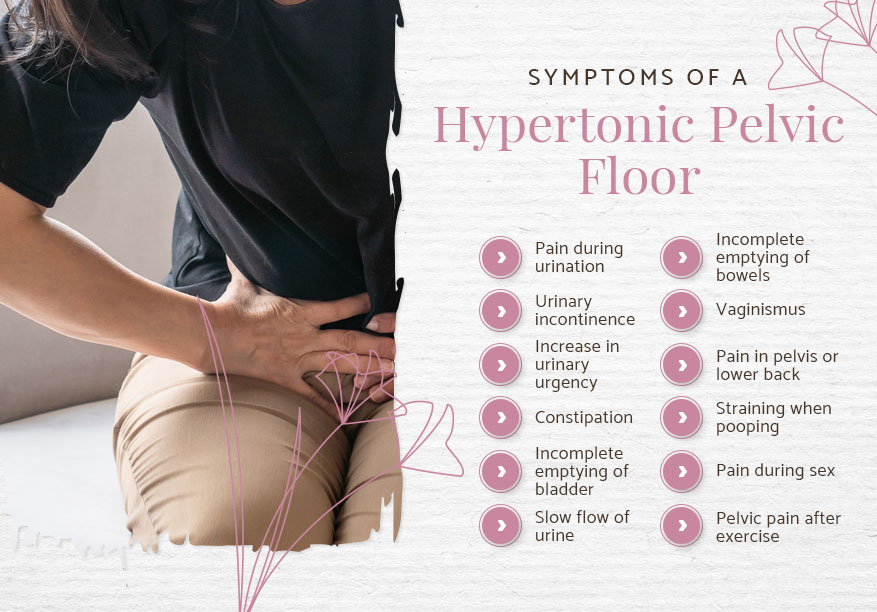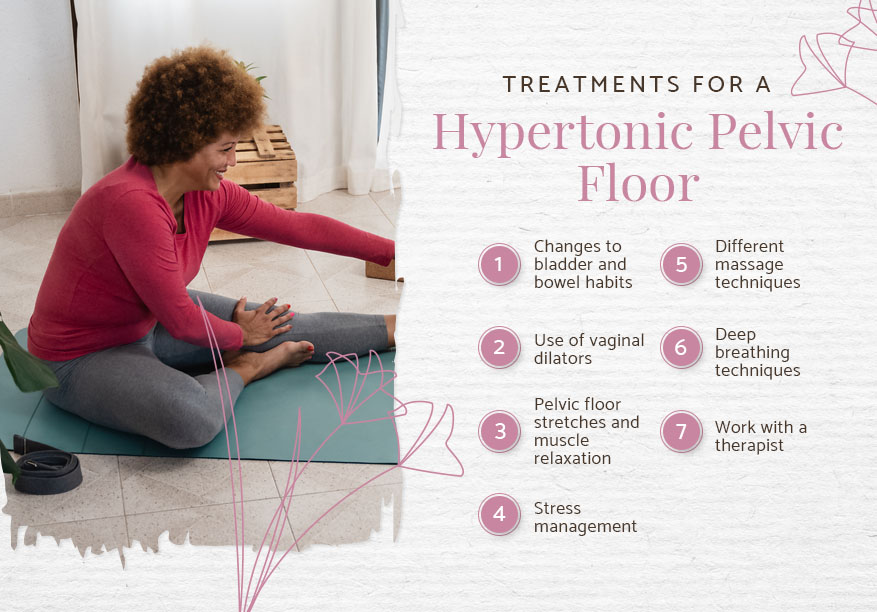
Hypertonic Pelvic Floor: Causes, Treatments, and More

“Hypertonic” means overactive, and refers to muscles that cannot relax, instead remaining in a continuous state of contraction. Any muscle in your body can become hypertonic, including the muscles in your pelvic floor. Because your pelvic floor is involved in so many bodily functions, a hypertonic pelvic floor can affect many different aspects of your life. If you suspect that you have a hypertonic pelvic floor, you should seek medical treatment so you can start living your life to the fullest again.
In this guide, we’ll explain what the symptoms of a hypertonic pelvic floor are, potential causes of a hypertonic floor, and some treatments that your doctor might recommend.
What Is a Hypertonic Pelvic Floor?
A hypertonic pelvic floor occurs when the muscles are overly tense and cannot relax. Because your pelvic muscles stay in a constant state of contraction, daily activities such as using the bathroom and having intercourse can be hampered.

Some symptoms of a hypertonic pelvic floor include:
- Pain during urination
- Increase in urinary frequency or urgency
- Urinary incontinence
- Incomplete emptying of the bladder
- Delayed start when urinating
- Slow flow of urine
- Constipation
- Incomplete emptying of the bowels
- Straining when pooping
- Pain in the pelvis, lower back, hips, and/or tailbone
- Vaginismus
- Pain during sex
- Pelvic pain after exercise
Causes of a Hypertonic Pelvic Floor
There are many potential causes of a hypertonic pelvic floor, and, in some cases, there might be more than one contributing factor. Your doctor will work with you to diagnose the causes of your hypertonic pelvic floor and to determine what treatments will be most effective for you. The diagnosis will likely involve a pelvic exam, and the doctor will also probably ask you to perform floor contractions so they can assess the tension in your muscles. The doctor may order additional tests if they suspect an underlying condition is worsening your hypertonic pelvic floor.
Various pelvic medical conditions are known for contributing to a hypertonic pelvic floor. For instance, endometriosis can cause a hypertonic pelvic floor due to the constant inflammation and pain, which causes the pelvic muscles to continually contract. Pregnancy can also be a contributing factor to a hypertonic pelvic floor due to the constant pressure the growing baby puts on the pelvic floor. Other pelvic conditions to consider include interstitial cystitis (also known as painful bladder syndrome), fibroids, polycystic ovarian disease (PCOD), pelvic inflammatory disease, and sexually transmitted diseases.
Learn More About Painful Bladder Syndrome Here
Abdominal conditions can also contribute to a hypertonic pelvic floor. This is because your abdominal region and your pelvis are located very close together, and many of the systems are interconnected. Inflammatory bowel conditions, such as irritable bowel syndrome (IBS) and ulcerative colitis, cause pain to the abdominal and pelvic area. These chronic conditions can cause your pelvic floor muscles to continually contract and eventually lead to a hypertonic pelvic floor.

Closely related to abdominal conditions are colorectal problems. Since constipation is a potential symptom of a hypertonic pelvic floor, it should come as no surprise that colorectal conditions such as hemorrhoids, anal fissures, and colectomies can increase your chances of developing a hypertonic pelvic floor.
Certain neurological conditions may also play a role in a hypertonic pelvic floor, especially if the nerves that govern the pelvic area are affected. Some examples of relevant neurological conditions include shingles, migraines, and multiple sclerosis. Rheumatic conditions that cause a lot of inflammation, such as fibromyalgia and connective tissue disorder, also increase your chances of developing a hypertonic pelvic floor.
Injuries and trauma to the pelvic floor area also increase the odds of developing a hypertonic pelvic floor. Pelvic tears from giving birth vaginally, and the resulting scar tissue, can also lead to ongoing tension in the pelvic floor.

Chronic stress, fear, and anxiety may increase your odds of developing a hypertonic pelvic floor. This is because our automatic “fight or flight” response makes our bodies unconsciously tuck in our tailbones, causing the pelvic muscles to contract. If you are constantly stressed, then those muscles will remain contracted for long periods of time, potentially resulting in a hypertonic pelvic floor.
If you frequently hold your urine or bowel movements for long periods of time, this can also cause your pelvic muscles to remain contracted. For instance, some people really hate using public toilets, so they will hold their urine all day long until they can use the bathroom at home again. Holding in your waste or urine requires the pelvic muscles to remain contracted, so if you do this often, it can result in a hypertonic pelvic floor.
People who work out often, and thus contract their pelvic muscles frequently, might also find themselves more prone to developing a hypertonic pelvic floor. If you are frequently contracting your pelvic muscles, then you also need to consciously relax and stretch them out so they don’t constantly carry tension. We’ll delve more into pelvic floor stretches in the next section — potential treatments.

Treatments for a Hypertonic Pelvic Floor
There are multiple different treatments available for a hypertonic pelvic floor, and your doctor will likely recommend a combination of them based on what your diagnostics reveal. Here are some treatments that you might end up trying.
Pelvic Floor Stretches and Muscle Relaxation
You have probably heard of Kegels, which are exercises that specifically target the pelvic muscles to contract. Kegel ball exercises are great for building up weak pelvic muscles and toning up the pelvic area, but they are the exact opposite of what you want when you are struggling with a hypertonic pelvic floor. Instead, you should seek out pelvic stretches such as the butterfly pose, happy baby pose, and child’s pose. These exercises will help you to stretch out your pelvic muscles and release some of the tension they are holding. Just make sure to practice stretches that release muscle tension. If you’re looking to strengthen your pelvic floor through yoga, read more in our blog on yoga for pelvic floor strengthening.
Deep Breathing Techniques
Breathing actually engages and relaxes your core and pelvic muscles, even if you don’t consciously notice it. This means that you can harness the power of deep breathing to help your body with pelvic floor release. There are seven different types of deep breathing exercises available, including diaphragmatic breathing, 360 breathing, and alternate nostril breathing. Experiment with different techniques to figure out which ones work best for you and relax your pelvic muscles the most. You will usually see the best results when you practice deep breathing at least once a day, every day (though you can do it more than once per day if you’d like!).
4 Pelvic Floor Release Stretches for Tight Muscles
Changes to Bladder and Bowel Habits
As outlined in the section above, certain lifestyle habits — such as holding your urine or excrement too long or working your pelvic muscles too much — can be contributing factors to a hypertonic pelvic floor. Your doctor may have you make certain changes to remove these factors from your life. For example, they may recommend using the restroom more frequently, eating more fiber to encourage bowel movements, or finding new workouts that won’t put as much stress on your pelvic floor. Over time, these lifestyle changes can make a big difference in your pelvic health.

Stress Management
Stress causes your entire body to tense up, including your pelvic floor — and the longer the stress goes on, the tenser your body becomes. Reducing your stress is one of the best things you can do for your overall health, which includes a hypertonic pelvic floor. Removing stressors as much as possible is obviously the most effective solution, but it’s impossible to remove every single stress trigger from your life. That’s why it’s also important to cultivate your stress management techniques, which can include meditation, working out, spending time with friends, and relaxing on your own.
Massage Techniques
Different massage techniques can be used to target different parts of the pelvic and abdominal regions. When done correctly, these massage techniques can help relieve tension and encourage the muscles to relax. However, if done improperly, the massage techniques can actually worsen your muscle tension, which is why it’s important to learn them from a trained physical therapist. There are also scar tissue massage techniques available that can help with recovery after injury or surgery once your wounds are completely healed. If you’re not sure if you are ready for scar tissue massage, your doctor and/or physical therapist can help guide you.
Use of Vaginal Dilators
Vaginal dilators are especially helpful for those who are experiencing vaginismus or pain during sex. Vaginal dilators are a set of insertable devices made of plastic or silicone that come in increasing sizes. You start by inserting the smallest one into your vagina for a few minutes a day, and over time, you work up to the largest size. If you have specific “hot spots” in your pelvic area, you may also find it helpful to use a pelvic wand, which is a thinner, curved insertable device. Pelvic wands can be used to press on smaller areas of muscles that are really tense, stimulating them to relax. Your pelvic floor therapist can help you figure out if dilators or wands (or both) would be beneficial, as well as how to use each of them properly.

Therapy
Pelvic floor therapy isn’t the only type of therapy that may be beneficial. For some people, their pelvic floor dysfunction is tied to sexual or physical trauma. Even if it isn’t related to these factors, having a hypertonic pelvic floor can make it difficult to have sex, causing relational difficulties. Psychological factors can worsen symptoms and hamper recovery, which is why it’s important to take a holistic approach to treating a hypertonic pelvic floor. You may find it helpful to work with a talk therapist and/or sex therapist to help treat your hypertonic pelvic floor from a different angle.
What Is Pelvic Floor Therapy? Learn More Here
At Sofia & Grace, we believe that women should feel empowered when it comes to their pelvic and bladder health. That’s why we created our resource hub, which is full of informative guides. We also have a private forum where you can connect with other women going through the same thing as you. Join the Sofia & Grace family today to find the support you need!
Image Credits
Chinnapong/Shutterstock.com
arigato/Shutterstock.com
Natalia Deriabina/Shutterstock.com
Vane Nunes/Shutterstock.com
Krakenimages/Shutterstock.com
Anna Kraynova/Shutterstock.com
Irene Moreno Palomino/Shutterstock.com
wavebreakmedia/Shutterstock.com